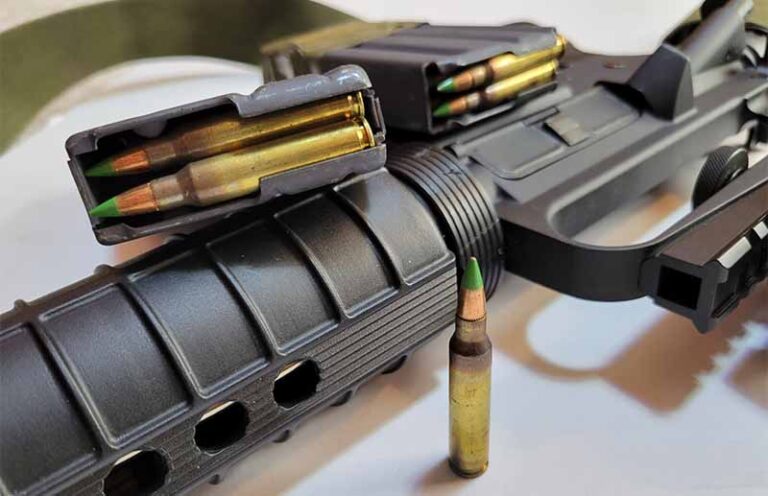
When it comes to feeding your AR-15, is green tip 5.56 ammo top-shelf, bottom of the barrel or somewhere in between?
Whether you know it as M855, SS109, or just green tip 5.56, this variety of 5.56x45mm NATO ammo is somewhat controversial. On the one hand, it’s been standard military issue for decades. On the other hand, “military issue” doesn’t mean that something is inherently the best at anything!
So, let's delve into the myths about 5.56 green tip, its origins, what it's actually good for and what to keep in mind while buying it.
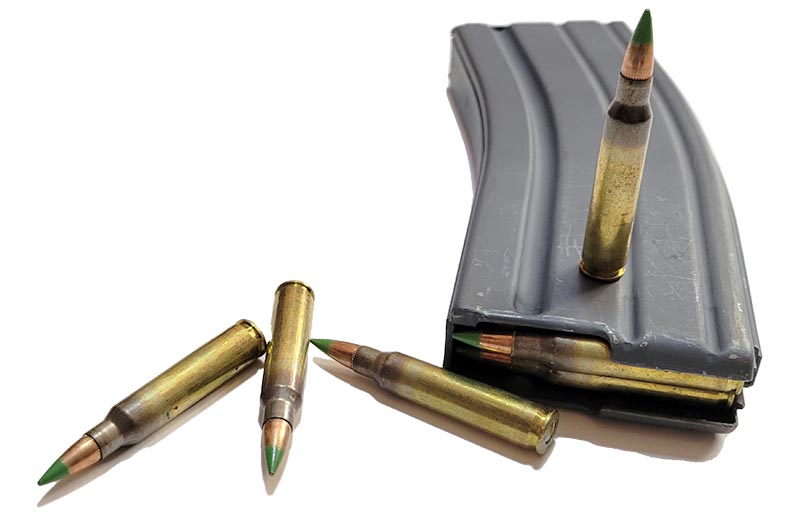
The First 5.56mm NATO Cartridge
What we now call “green tip” 5.56mm NATO ammunition was originally developed by FN Herstal in the late 1970s. The idea was to create a standardized (STANAG) NATO cartridge that would work with service rifles like the M16 family, FAMAS, CETME-L and Steyr AUG, as well as FN's (then) upcoming Minimi light machine gun, which would soon be adopted by the U.S. as the M249.
The cartridge had to exhibit certain performance characteristics, including penetration potential at long range as well as stable flight. To accomplish this, FN added a 7-grain steel tip insert which moved the center of gravity a little further back and raised the total bullet weight from 55 grains to 62 grains.
The added steel tip was able to penetrate a mild steel plate (roughly similar to the thickness/metallurgy of a .135-inch thick USGI steel helmet from WWII) at 800 meters. It satisfied this and all other requirements and was adopted as the standard load for 5.56x45mm NATO.
FN's internal designation for the bullet core and design is/was SS109. The American military gave it its own designation, M855, and painted the tip green to distinguish it from other issued loads.
An improved version, M855A1, was eventually introduced with a revised jacket over a copper bullet with a steel penetrator made from a harder steel alloy. That, however, is a discussion for another day.
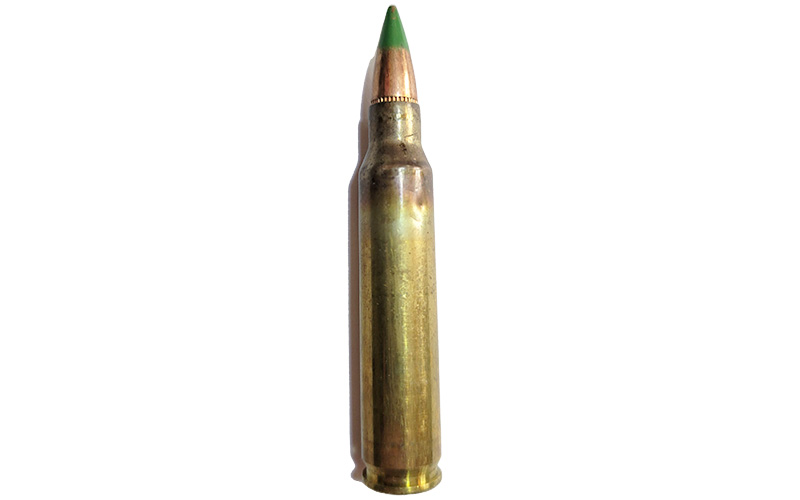
Is Green Tip 5.56 Armor Piercing?
Green tip 5.56mm can pierce some armor, but it isn't made for that purpose. Yes, part of the original development cycle was piercing very light armor, but that alone does not armor-piercing ammunition make.
Bear in mind that one of the original tests of M193 (55-grain FMJ) was penetrating a USGI steel helmet at 500 yards, which it passed. Further, M193/XM193 has been repeatedly proven to penetrate AR500 steel plates while M855 has a track record of less reliably doing so.
M995 “black tip,” which is a 52-grain bullet with a tungsten core, is absolutely an armor-piercing round as it was designed to fill this role. When it comes to M855, it’s closer to the truth to say it can pierce certain kinds of armor, but A.) it isn't made to, and B.) there's some evidence it's not very good at it anyway.
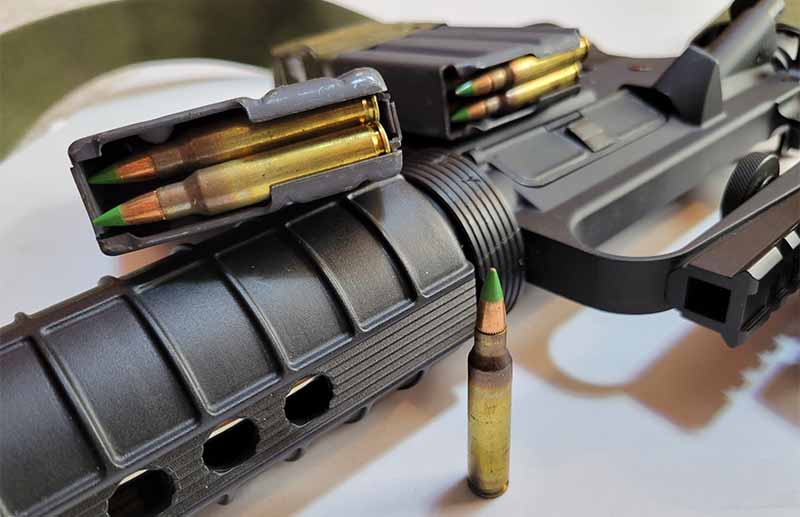
M855 Vs. Other 5.56 Loads
Using ShootersCalculator, we cooked up some tables representative of each load in question. Here’s a 1,000-yard trajectory table for green tip M855, made using the average G1 BC of .304, a muzzle velocity of 3,062 fps and a 2.6-inch sight height to account for standard AR-15 irons. All tables were made presuming a 100-yard zero, a 10 mph 90-degree crosswind and zero corrections for atmosphere.
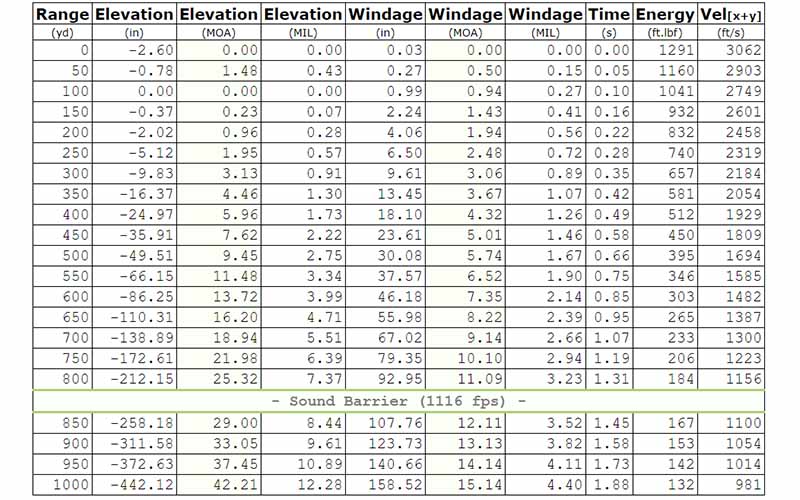
And here's the same table for M193, presuming muzzle velocity of 3,100 fps and a G1 ballistic coefficient of .243, which is standard for M193 ball.
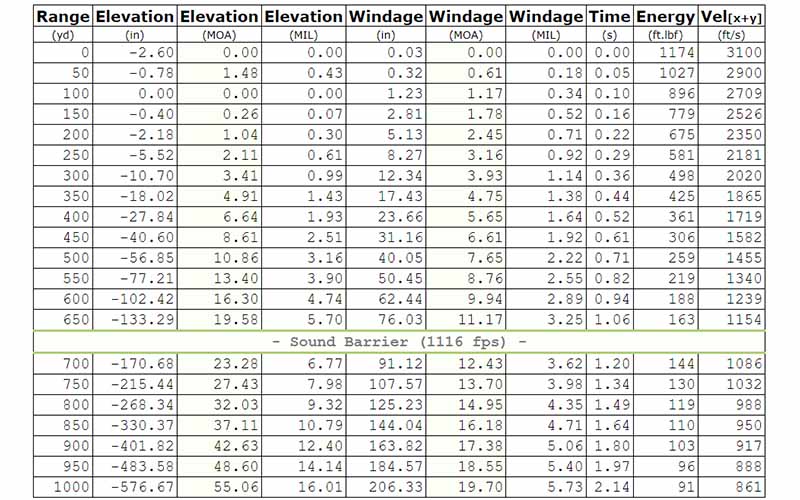
As you can see, M855 stays supersonic for an additional 150 yards, has drifted 10 fewer inches and dropped about 7 fewer inches at 500 yards, all while retaining more energy than M193.
However, bear in mind that the fragmentation threshold for M855 and M193 is roughly 2,600 fps (below this velocity, both projectiles become unlikely to reliably fragment). M855 drops to that velocity in 150 yards, and M193 at 125 yards.
While M855 clearly has slightly longer legs than M193, there are more loads available than those two. Here’s a trajectory table for something a bit less common.

This is a trajectory table for Mk262, the Black Hills 77-grain Sierra Match King load issued by the military that has an advertised G1 BC of .373 and muzzle velocity of 2,863. Compared to M855, it stays supersonic for an additional 100 yards, but because the SMK bullet has a lower fragmentation threshold of around 1,900 fps, it actually extends the nominal effective range to just over 400 yards. Compared to M855’s nominal effective range of 150 yards, that’s quite impressive.
Point being, while M855 is marginally better than M193 on paper, it’s also not the best 5.56 load available. Whether you’re after maximum range or maximum effect on target, there are many better options than either of these surplus loads.
Green Tip 5.56 For Defense
Frankly, green tip 5.56 is a lousy choice for self-defense.
Fragmentation and yawing (tumbling) on impact are ostensibly the big benefits of 5.56x45mm NATO’s terminal performance, but the steel penetrator changes the center of gravity of the bullet.
That leads to what's called “fleet yaw,” a phenomenon (discovered by Dr. Martin Fackler) wherein some projectiles from the same lot of ammunition will yaw and fragment, but not all will. The same lot of ammunition has been observed to perform flawlessly in one rifle, but terribly out of an identical rifle.
When green tip doesn't yaw or fragment, it's basically just ice-picking the target with a .224-caliber bullet.

Veterans of the Battle of Mogadishu reported similar findings. Some who served there were completely satisfied with 5.56 green tip while others reported having to hit a target several times before they were incapacitated.
Ballistic testing shows that 62-grain green tip 5.56 does not yaw as reliably or as soon in tissue when compared to M193, typically only doing so until it’s 7 or 8 inches deep. It also does so less reliably at shorter ranges and when traveling at the slower velocities produced by rifles with short barrels.
Other 5.56x45mm loads, such as bonded soft points and 77-grain OTM, have more reliable expansion or yawing at shorter ranges and at slower velocities. They're also superior when used for hitting targets through intermediate barriers.
So, green tip is lousy self-defense ammunition. It's also lousy for hunting, and guess what the recommended 5.56mm hunting loads are? 55- and 62-grain bonded soft points.
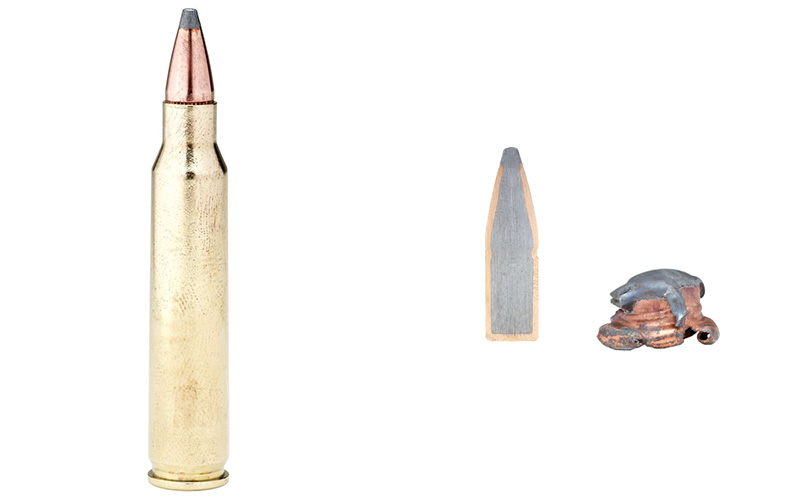
Green Tip 5.56 For Training
When it comes to range ammo, M855 has pros and cons. While it is generally pretty cheap and available, its use is also banned at many ranges. This is because the steel insert is hard on steel targets and poses a bigger risk of starting a fire.
If you want to use it to shoot your own steel targets on your own land, that's up to you, but if you primarily use public ranges then green tip isn't the best choice.
Not All Green Tip 5.56 Is Created Equal
Green tip 5.56 ammo can suffer from the same problem as AR-15 rifles and 1911 pistols. Anyone can make them…which means some people are going to cut corners to fill a demand rather than turn out a good product.
In other words, not all green tip 5.56 is created equal. Dozens of ammunition factories, ranging from Lake City to Winchester to IMI to PMC to cowboy outfits that you've never heard of all make their own M855 clone, and not all of them are necessarily good.
They also aren't all identical, even when they share the same name. Military ammunition is made to strict specifications that lay out every single technical detail, from the primer to the propellant to the projectile and all points in between. When buying a commercial copy of M855 rather than true military surplus, you have no guarantee that whoever made it did so correctly.
For instance, the powder for actual M855 is supposed to be WC 844/Hogdon H335. While H335 is hardly the rarest propellant in the world, it's certainly the case that you can approximate the velocity with a different and cheaper powder, but that's going to change the pressure curve (which matters in a gun that runs on gas!) and so on.
Does any ammunition manufacturer you know of specify what powder they use? What primer? Some advertise which bullet, but not much else.
Green tip 5.56 is also a popular load for remanufactured ammunition, and while plenty is of good quality, a lot of it isn't. That's why a lot of top shooting schools and instructors don't allow remanufactured ammo in their courses.
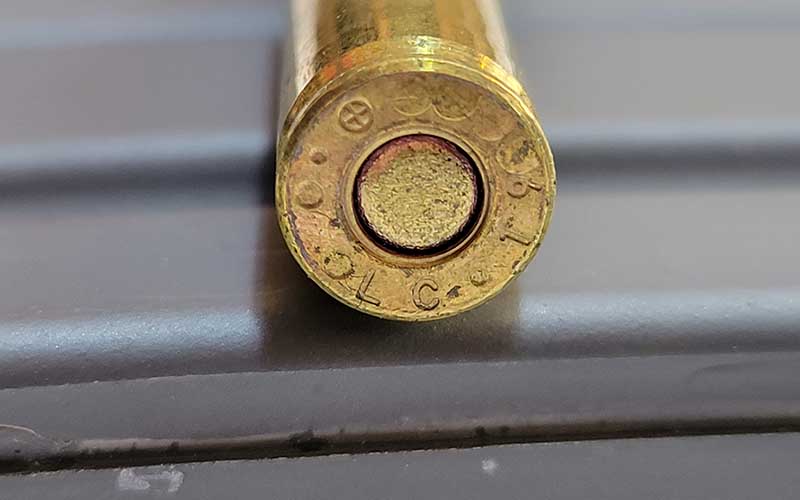
Point being, M855 is one of the most reproduced/cloned loadings in the world, and the further you get from the original the more problems may arise. You probably won't have too many issues with, say, Winchester white box M855 or PMC Bronze, but you might from someone else's. Manufacturers that primarily serve the military such as Lake City are the safest bet.
Due to its low price and high availability, green tip 5.56 remains a fine choice for training ammunition. Just be aware that the load possesses no mystical qualities and isn’t particularly better than any other variety of 5.56. If you’re looking for something to use for defense or hunting, there are many better options out there.
Raise Your Ammo IQ:
- Beyond The 6.5 Creedmoor: The Other 6.5 Cartridges
- The Lonesome Story Of The Long-Lost 8mm
- Why The .300 H&H Magnum Still Endures
- .350 Legend Vs .450 Bushmaster: Does One Win Out For Hunting?

Next Step: Get your FREE Printable Target Pack
Enhance your shooting precision with our 62 MOA Targets, perfect for rifles and handguns. Crafted in collaboration with Storm Tactical for accuracy and versatility.
Subscribe to the Gun Digest email newsletter and get your downloadable target pack sent straight to your inbox. Stay updated with the latest firearms info in the industry.

![Best Concealed Carry Guns In 2025 [Field Tested] Wilson Combat EDC X9S 1](https://gundigest.com/wp-content/uploads/Wilson-Combat-EDC-X9S-1-324x160.jpg)


![Best 9mm Carbine: Affordable PCCs [Tested] Ruger Carbine Shooting](https://gundigest.com/wp-content/uploads/Ruger-Carbine-Shooting-100x70.jpg)
![Best AR-15: Top Options Available Today [Field Tested] Harrington and Richardson PSA XM177E2 feature](https://gundigest.com/wp-content/uploads/Harrington-and-Richardson-PSA-XM177E2-feature-100x70.jpg)

“green tip 5.56 is a lousy choice for self-defense.”
What if your attackers are wearing body armor? (e.g. Ruby Ridge, Waco) Then it’s not so lousy, I’d guess.
Thanks to Olympic Arms, we can’t have M995 in 5.56, so green tip is all we’ve got.
Great article! loaded with good info!
Thank you!
It’s obvious the author doesn’t care for Win.LC M855 62gr. ammo. I don’t agree with most of what he said either. I always maintain at least 2000rds.plus. My AR15’s love this stuff and I will continue to buy in the future.
Who’d be the FIRST to ‘stand in line’ and get “ice-picked”..and state oh yeahhh, “that was some lousy-self-defense ammo”. Geez. IF you DON’T WANT OVER-penetration..say, in a home intrusion, etc, don’t USE the stuff. THIS article mentioned some G-tip that “punched through AR 500”..? NOT any AR 500 that is “good” AR 500 it won’t. It’ll create divots and deface it messing up a ‘clean’ target. BUT it won’t punch through the real stuff, certainly not 3/8”. M193 FMJ is about as good as ANY 5.56 that’s ‘mil spec’ ammo FOR “S-D” as you’ll find..as long as the rifling & twist-rate, bbl length are compatible with the round. As FOR “HOME defense”, 5.56 isn’t THE best choice. It will certainly WORK though..
when it comes to the 5.56×45 or even .223Rem. I am a huge fan, but at the same time disappointed in ammunition manufacturers. I think that 5.56/223 has way more to offer as a cartridge. with all of the modern propellent/powders, projectiles, and case technology, especially the newer Bimetal cases, such as Sig Sauer’s new bimetal case, used in the militaries Sig MCX Spear M7 platform using the 6.8×51/277Fury cartridge, why not take that case technology, and apply it to the 5.56Nato cartridge. now there is a great idea, but nobody seems to be doing anymore research and development, with the 5.56/223 they are to busy trying to make the bigger better cartridges, but the military stuck with the M16/M4 5.56/223 platform for a reason, it’s because it is an awesome cartridge for what it is. Lets see some new and modern 5.56/223 cartridges. I know it can be done, and I know 5.56/223 still has allot to offer.
“So, green tip is lousy self-defense ammunition. It’s also lousy for hunting…” That is overstating the situation. Green tip can easily kill someone, therefore it is not “lousy” self-defense ammunition. It may not be ideal. It may not be the best. But it’s not “lousy”. Even .22 LR is not “lousy” self-defense ammunition. It too can kill someone. A BB gun is “lousy” for self-defense.
Not if you put someone’s eye out!
lol true so true